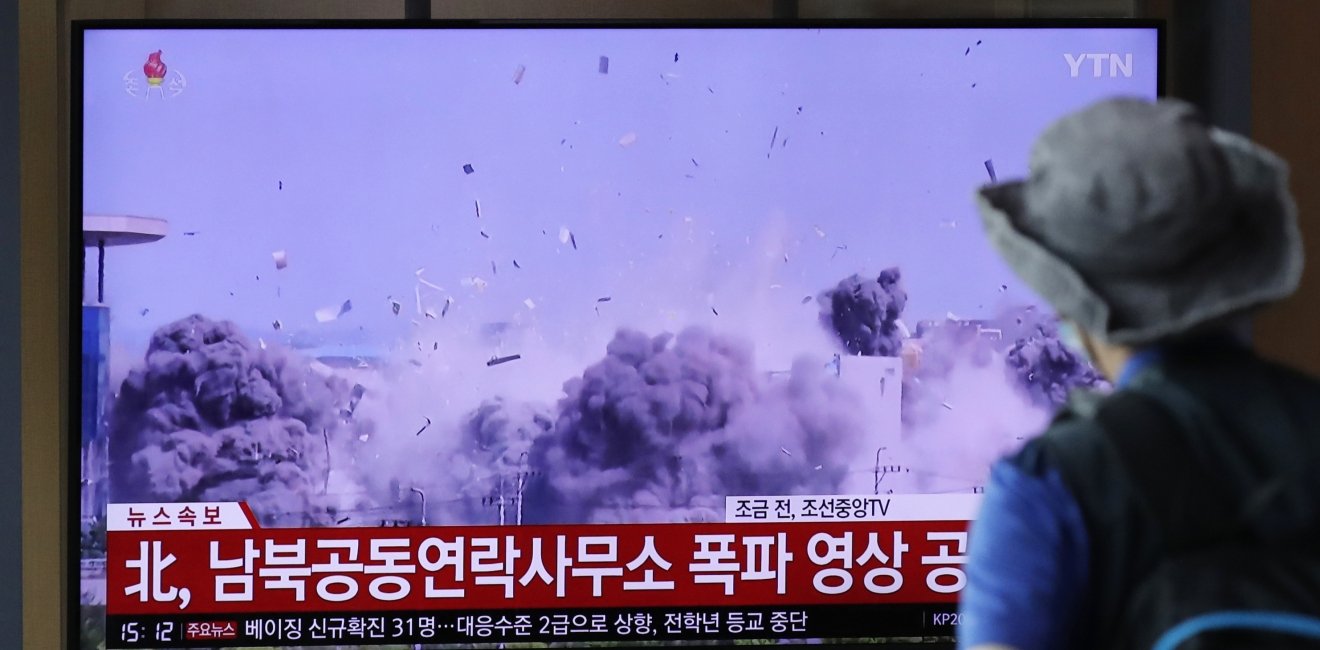More Than Leaflets: What’s Behind North Korea’s Threats and Provocations?
Throughout June, North Korea has ratcheted up vitriol and pressure on South Korea.

A blog of the Indo-Pacific Program
Throughout June, North Korea has ratcheted up vitriol and pressure on South Korea.

In the past week, North Korea has blown up a joint liaison office it had shared with the South Koreans and threatened to reoccupy guard posts vacated as part of a military agreement with Seoul. In the latest threats, state media showed workers preparing propaganda pamphlets to send across the border and the regime has warned South Korea to prepare for the worst.
The destruction of the joint liaison office in the North Korean border town of Kaesong occurred one day after the 20th anniversary of the historic, first-ever inter-Korean summit of 2000.
Established following the April 2018 summit between South Korean President Moon Jae-in and North Korea’s Chairman Kim Jong Un, the North-South liaison office was a symbol of renewed inter-Korean reconciliation and one tangible result of the Panmunjom Declaration, signed during the summit at the DMZ dividing the two Koreas.
North Korea also warned that it would redeploy troops to areas where the two Koreas had joint projects in the past, and said it would reinstall border guard posts removed in 2018. Moves to reinstall loudspeakers along the border have also been spotted.
The reason claimed by Pyongyang is leafleting by defector activists in South Korea who have sought to send balloons filled with anti-Pyongyang leaflets across the border. Besides anti-regime brochures, these balloons contain USB sticks, dollar bills, and sometimes even small radios intended to inform and enlighten North Korean residents.
Pyongyang denounced the Moon government’s lack of action to block them as a violation of the April 2018 joint declaration, in which both Koreas “agreed to stop all the hostile acts, including loudspeaker broadcasting and scattering of leaflets in the areas along the Military Demarcation Line.”
The agreement did not distinguish between government propaganda and civilian leafleting, which appears to have resulted in major differences between Seoul and Pyongyang’s interpretation of the government role in stopping activists from sending off balloons.
With the recent civilian leafleting raising inter-Korean tensions to new highs, the South Korean authorities have blocked activists, citing danger to the lives and safety of residents in the border towns. The ruling Minju Party has also said it would legislate a law to prevent civilian leafleting across the inter-Korean border to fundamentally resolve the controversy and protect the residents in the region.
Pyongyang, expressing extreme aversion to this leafleting by defector activists —and labeling them “human scum” — has announced the 2018 agreement void, and vowed to repay Seoul with millions of anti-South Korea leaflets prepared by North Korean residents. Though military action plans have been suspended — in yet another calibrated move — following Kim Jong Un’s decision at the June 23 preliminary meeting of the Central Military Commission of the Workers’ Party which “took stock of the prevailing situation”, the situation remains precarious.
While North Korea has always been hypersensitive about anti-regime leaflets, the following reasons also appear to be fueling its latest aggression:
Pyongyang’s growing frustration and anger at South Korea for its inability or lack of will to:
North Korea’s carefully calculated plan to draw U.S. attention and create tensions for better leverage in future negotiations based on its assessment that:
Reemergence of the military in North Korean power structure:
North Korea usually has a deliberate and purposeful agenda driving these decisions, including domestic political factors as well as its intended and measured posture to the outside world. More often than not, however, South Korea bears the brunt of Pyongyang’s provocations, be they vitriol or aggression in action, placing inter-Korean relations on what seems like a repeating rollercoaster of developments.
The explosion of the joint liaison office appears to be only the beginning of renewed tensions on the Korean Peninsula, demanding better and well-thought out measures by South Korea and the United States to prevent North Korea from further escalating the situation and to bring it back to dialogue table before it completely annihilates room for diplomacy.
___
Soojin Park is a Public Policy Fellow with the Woodrow Wilson Center’s Asia Program. Park served as deputy spokesperson for the Ministry of Unification in the South Korean government.
The views expressed are the author's alone, and do not represent the views of the U.S. Government or the Wilson Center. Copyright 2020, Asia Program. All rights reserved.


The Indo-Pacific Program promotes policy debate and intellectual discussions on US interests in the Asia-Pacific as well as political, economic, security, and social issues relating to the world’s most populous and economically dynamic region. Read more


The Center for Korean History and Public Policy was established in 2015 with the generous support of the Hyundai Motor Company and the Korea Foundation to provide a coherent, long-term platform for improving historical understanding of Korea and informing the public policy debate on the Korean peninsula in the United States and beyond. Read more
